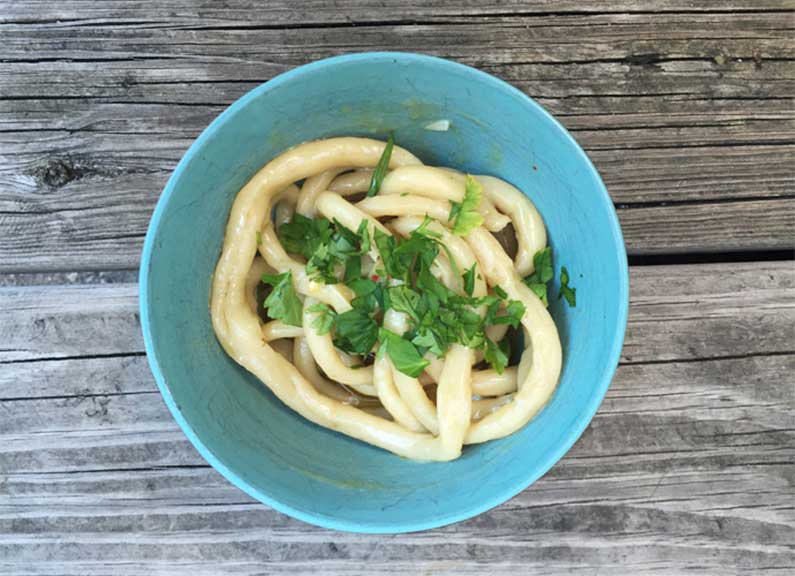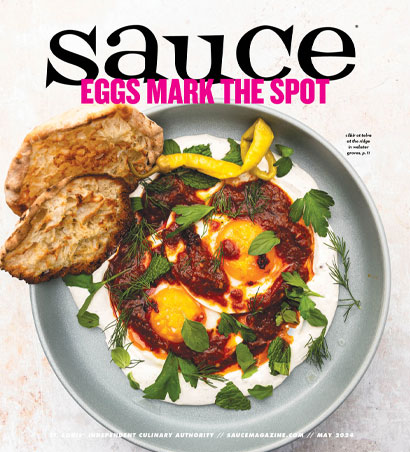
Recipe: Pici Aglio E Olio by Marc Vetri
A confession: I have never made pasta. I don’t own the fancy pasta roller attachment for my mixer; I don’t even have the one that attaches to the countertop. So I was in a tad over my head when I picked up Marc Vetri’s manifesto, Mastering Pasta: The Art and Practice of Handmade Pasta, Gnocchi and Risotto for this week’s By the Book. The first two chapters don’t even include recipes, just a meticulous scientific discussion of how complex combining wheat, egg and water really is.
I waded into the pasta-making pool with Pici Aglio E Olio, one of Vetri’s recipes that didn’t require a pasta roller. All I needed was bread flour, water, a touch of oil and elbow grease to churn out long ropes of pici. Though Vetri wanted noodles as long as 6 feet, my lack of counter space and coordination meant I halved the pasta dough and went for 3-foot-long noodles instead. Fresh pasta takes only a few minutes to cook, and my noodles hopped from boiling water into olive oil spiked with garlic and anchovy-based fish sauce in less than five minutes.
The final dish was simple, yet oh-so rich with yard-long toothsome noodles coated in a golden, pungent sauce. Don't skimp on quality ingredients here; good olive oil and quality fish sauce are the primary flavors, so get what you pay for. Vetri’s recipe is almost overly detailed, but as a pasta novice, I appreciated the attention to technique. Without such specific instructions, I doubt my dish would have been as successful. Maybe it’s time to buy that countertop pasta roller after all.
Skill level: Intermediate to advanced cooks
This book is for: People with an Aziz Ansari-level of love for pasta and are prepared for complex sauce recipes, too.
Other recipes to try: Heirloom tomato and burrata lasagna, potato gnocchi with corn crema and corn salad
The verdict: After much debate, the reigning champ was dethroned. Mastering Pasta takes the crown.
Pici Aglio E Olio
4 servings
1 lb. pici dough (recipe follows)
1 cup plus 1 Tbsp. extra-virgin olive oil
Semolina or cornmeal for dusting
10 cloves garlic, cut into matchsticks
1-2 tsp. red pepper flakes
3-4 Tbsp. garum or good-quality Asian fish sauce
1½ Tbsp. chopped mixed herb (parsley, oregano and thyme are nice)
• Roll out the dough on a lightly floured work surface about 1/8-inch thick and about 18 inches square. Rub the surface of the dough with about 1 tablespoon of the oil, coating it evenly. The oil enriches the dough and keeps it from drying out as you work.
• Pour a pile of semolina or cornmeal near the corner of the work surface. Cut the dough square into strips ¾-to 1-inch wide. Starting at one end of a strip, use the heel of your palm to roll the strip gently back and forth on the work surface, stretching it lengthwise until forms a rope about ¼ inch in diameter. If necessary, rub a little water on the work surface to help the rope stick and roll more easily. As you roll, set the shaped portion of the rope into the semolina or cornmeal pile to prevent it from sticking to itself. You should end up with a rope 5 to 6 feet long in the pile of semolina or cornmeal. Pick up one end of the rope, drape it around a finger, and then continue to drape the entire rope around your fingers. Place the rope in parallel lines on a rimmed baking sheet dusted with semolina or cornmeal. Repeat with the remaining dough. Use the pici immediately or cover them and let them stand at room temperature for up to 2 hours. You can also freeze them in a single layer, transfer them to a zipper-lock bag, and freeze them for up to 1 month. Take the pasta straight from the freezer to the boiling pasta water.
• Bring a large pot of salted water to a boil. Drop in the pici and cover the pot to quickly return the water to a boil. Cook the pasta until it is tender but still a little chewy when bitten, 2 to 3 minutes.
• Meanwhile, heat the remaining 1 cup oil in a large, deep saute pan over medium heat. Add the garlic and cook it, stirring occasionally, until aromatic but not brown, 2 to 3 minutes. Remove the pan from the heat and stir in 1 teaspoon of the pepper flakes and 3 tablespoons of the garum.
• Using tongs, drain the pasta by transferring it to the pan of sauce. Reserve the pasta water. Add 1¾ cups of the pasta water to the pan and stir vigorously over medium-high heat until the sauce reduces slightly, gets creamy, and coats the pasta, 2 to 3 minutes. Keep the pasta moving until the pasta and sauce become one thing in the pan. Taste it, adding more pepper flakes and garum until it tastes good to you. Stir in the herbs.
• Dish out the pasta onto warmed plates.
Pici Dough
1 pound
2¼ cups bread flour (11.5 percent protein), plus more for dusting
1 Tbsp. olive oil
¼ cup water, or more if needed
• Sift flour into a bowl. Mix in the oil and water with a fork or spoon until the dough comes together. It will look raggy at first; continue adding water by the tablespoon until the dough can be gathered into a ball. You may need to add up to 5 tablespoons more water, depending on the humidity in the room.
• Turn out the dough onto a lightly floured work surface and knead it until it feels soft and smooth, about 3 minutes. Cover the dough and let it rest so it can relax, at least 5 minutes or up to 1 hour. Or wrap the dough in plastic wrap and refrigerate it for up to 3 days.
Reprinted with permission from 10 Speed Press
Tags : Recipes





